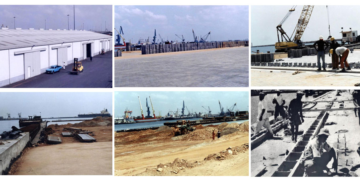Today in History, exactly 58 years ago, the Tema Port was formally opened by Dr. Kwame Nkrumah on Feb. 10, 1962.

Watched by a crowd of cheering, singing people, President Kwame Nkrumah formally opened Tema port, Ghana’s GBP18-million harbour about 18-miles east of Accra.
After unveiling the memorial plaque, the president made a speech outlining Tema’s history. Kwame Nkrumah said the independent states of Africa should now be thinking seriously of ways and means of building up a common market of a united Africa, “rather than allow ourselves to be lured by the dubious advantages of the European common market”.
He paid tribute to the british consulting engineers and contractors responsible for the port’s construction.
Tema Port is the biggest of two seaports of Ghana, handling 80 per cent of the country’s national exports and imports.
READ MORE: Today In Sports History: Egypt beat Sudan to win first AFCON match
The harbour is situated along the Gulf of Guinea, 18 miles from the capital Accra, and it
serves both as a loading and unloading port for goods, both for Ghana and the land-locked countries to the north.
Tema services a wide range of industrial and commercial companies, producing or handling everything from petroleum products, cement and food items, to iron, steel, aluminium products and textiles.
Most of the country’s main export, cocoa, is also shipped from Tema Port.
The Tema harbour covers a total land area of 3.9 million square meters with the water-enclosed area being 1.7 million square meters.
It has 5 kilometres of breakwaters, 12 deep-water berths, one oil-tanker berth, one dockyard, warehouses and transit sheds.
Nearby is also a fishing harbour with facilities that handles fish processing.
Construction
After independence, under the leadership of Ghana’s first president Kwame Nkrumah, the construction of the Tema harbour began in the 1950s and was commissioned in 1962.
Construction of Tema Port began in 1954 by Sir William Halcrow and partners.
The general port plan originally comprised of two breakwaters enclosing an area of 500 acres of water with twelve berths, eight of which were situated on two quays, four transit sheds, offices, two cocoa sheds and sites for a dry dock, a slipway and a workshop.
By 1958 construction was advanced enough to enable a cargo vessel the “Oti River” to berth. Regular traffic however started after the commissioning in 1962.




















